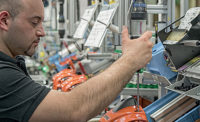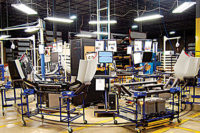For many years, manufacturers have used modular systems to automate a wide range of assembly processes. They know that a properly designed system increases productivity, lowers costs and ensures manufacturing quality.
Modular automation can be as simple as a one-axis device or a complex multiaxis system. Either configuration requires a prime mover, which is a rotary actuator or linear slide. As more axes or motions are needed, two or more linear or rotary actuators with fixturing and tooling are required with an application-specific end-effector. To maximize system life, speed and accuracy must be considered, and each component properly sized.
Many component suppliers provide sizing software that saves time and lessens design risk by enabling engineers to input their requirements and print out a list of product models and sizes that will meet their needs. These suppliers will also review a particular application and make specific recommendations for the best choice of components, whether standard or specialized.
When designing a modular automation system, a manufacturer might be inclined to begin with the prime mover, which carries the majority of the load. However, the better choice is to start with the end-effector and work backwards to the prime mover. This is because any prime mover that carries the end-effector must have the required capacity for the effector and its payload.
End-effectors
The most common end-effector used in modular automation is a gripper. Another type is vacuum cups. Each end-effector (and accompanying tooling) must be the correct type and size to ensure proper grasping of the part while withstanding dynamic loads associated with motion.
Grippers can be small enough to handle tiny electrical components or large enough to lift engine blocks. Some suppliers offer a wide variety of specialized grippers, including those made of stainless steel or plastic for harsh environments.
The gripper’s jaws can pivot or move at an angle or in a parallel motion. Angular grippers tend to cost less and provide a fairly wide jaw opening relative to the distance from the jaw pivot point. Parallel grippers are popular because they provide consistent positioning of the workload, particularly when the part being handled has varying dimensions.
Angular and parallel grippers can have two to four moving jaws, depending on the application requirements. In some cases, three-jaw grippers are used because they can easily center round parts.
Manufacturers need to decide if they want to use grippers with synchronized or nonsynchronized jaws. Synchronized jaws are controlled or coupled to ensure that the part is consistently placed in the same position. Nonsynchronized jaws move independently and compensate for the position of the part during gripping.
Grippers are usually powered pneumatically, although electric-powered grippers are growing in popularity. Pneumatic grippers provide a great deal of force relative to their size and weight. Electric grippers tend to produce less force, but offer more flexibility regarding jaw positioning and level of grip force. They can weigh more than a comparable pneumatic gripper, depending on the motor size.
Some applications will require that the gripper retain the part in the event of a power loss. This can be accomplished through the use of internal springs or built-in jaw locking mechanisms.
Vacuum cups provide an effective way to grasp flat and contoured part surfaces. These cups are usually round, come in a wide range of sizes and styles, and are relatively inexpensive.
Vacuum cups are made of rubber and include a flared lip to form a flexible seal against a workpiece. This design allows the cup to be evacuated with a vacuum pump. Several cups can be connected to a central pump, or a small vacuum pump can be used for each cup.
Industrial vacuum cups usually employ a metal fitting for mounting the cup and connecting a vacuum source to allow the inner volume to be evacuated. These cups can be flat or have various configurations that incorporate bellows.
A flat cup works well for grabbing flat surfaces and for applications with a shear load. Cups with bellows are designed for heavy parts that are convex or concave.
The correct number of vacuum cups required for an automation system will vary. For example, a system with rapidly moving contoured pieces might require two vacuum cups rather than one. Multiple cups increase the total area and achieve a desired load capacity (lifting and shear), while providing a generous safety factor.
Prime Movers
A rotary actuator or linear slide can be the prime mover in a modular automation system. It can also provide secondary motion or rotate the end-effector with a wrist motion. The actuator is usually pneumatic, although more electric actuators have been used in recent years.
The actuator must be configured to produce the exact amount of rotation required. Its rotation can be output via a keyed shaft, a hub or a flat mounting surface. Some rotary actuators offer up to five positions, allowing for more flexibility.
The actuator must be properly sized to handle the load and kinetic energy generated at the end of rotational travel. The actuator can also be outfitted with shock absorbers to increase its kinetic energy capability. This is necessary because most actuators can rotate a greater load than they are able to stop.
Linear slides are driven pneumatically or with electricity, depending on the application. Pneumatic slides provide cost-effective guided linear motion, while offering two, three or more positions.
These slides are available in a saddle or carriage configuration, where the load-carrying member moves between two end plates on a bearing system. The slides are also available in a cantilever or thruster style, where a tool plate supported by a bearing system reaches out to support an overhung load.
Electric slides provide more flexibility. Their positioning is almost infinite, depending on the type of motor and control package used to power the unit. Electric
Electric slides provide more flexibility. Their positioning is almost infinite, depending on the type of motor and control package used to power the unit. |
slides also are becoming more cost-effective, as the cost of electric motors and controls continues to decline.
These slides come in saddle and cantilever configurations. Saddle-type slides can be driven by a ballscrew, belt or linear motor. Belt and linear motors provide the highest speeds.
Linear slides feature either of two types of bearing systems. The first incorporates round shafts with either linear ball bushings or composite bearings to support the load. The second uses profile rail bearings combined with either a cross roller or a reciprocating ball-bearing carriage. Slides that incorporate the profile rail typically have a higher load capacity with less deflection.
Finally, linear slides can be easily combined to provide multiaxis motion. Some suppliers allow the direct attachment of one slide to another. Others offer transition plates that allow for a versatile connection. As always, the slides must be properly sized for load capacity, deflection, speed and kinetic energy.
Five Considerations When Sizing a Gripper
Motion. Remember that gripper acceleration and deceleration create inertia, which can increase the gripper’s lift capability requirements. Also make sure the jaw tooling is properly designed so it encapsulates the part as it moves.
Environment. Oil and Teflon spray are often present in assembly work areas. Be aware that both can make work areas slippery.
External Forces. These include machining that takes place as the gripper holds a part.
Orientation. Forces can be applied to a part from several different directions.
Part Presentation. Know precisely how the part will be presented to the gripper.
Top Five Considerations When Building a Modular Automation System
Environment. How often will the actuators be exposed to heat, dust, wash-downs, and other environmental extremes?
Part Weight and Size. Always take into account the geometry, dimensions and mass of the parts or components in motion.
Motion Sequence and Strokes. Know the exact stroke distance (in inches or millimeters). How many axes of motion are there?
Cycle Time. Keep it as short as necessary.
Space Constraints or External Forces. Are there dimensional constraints or additional motions and forces being applied to the actuators? If so, plan accordingly.







